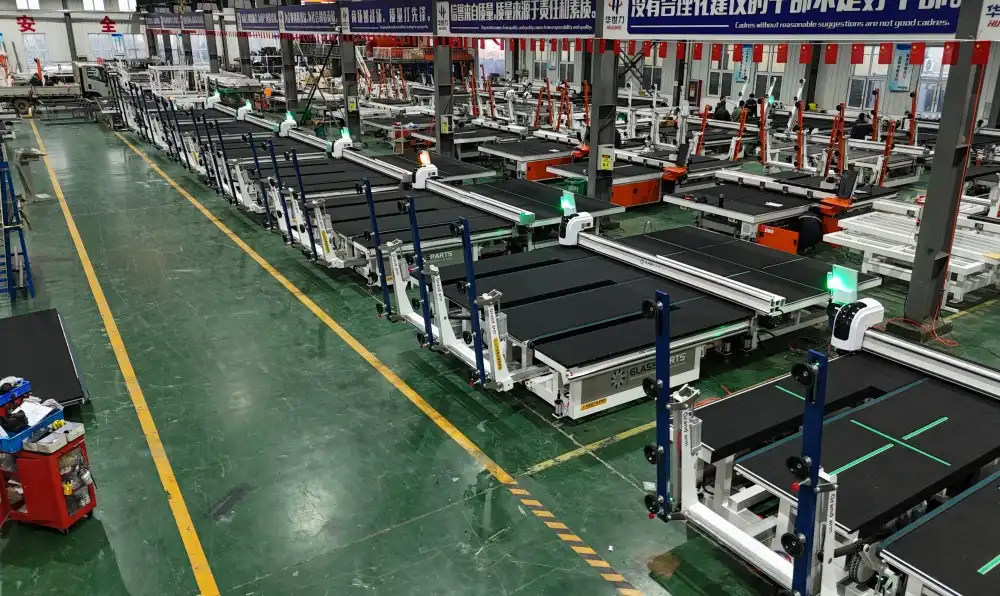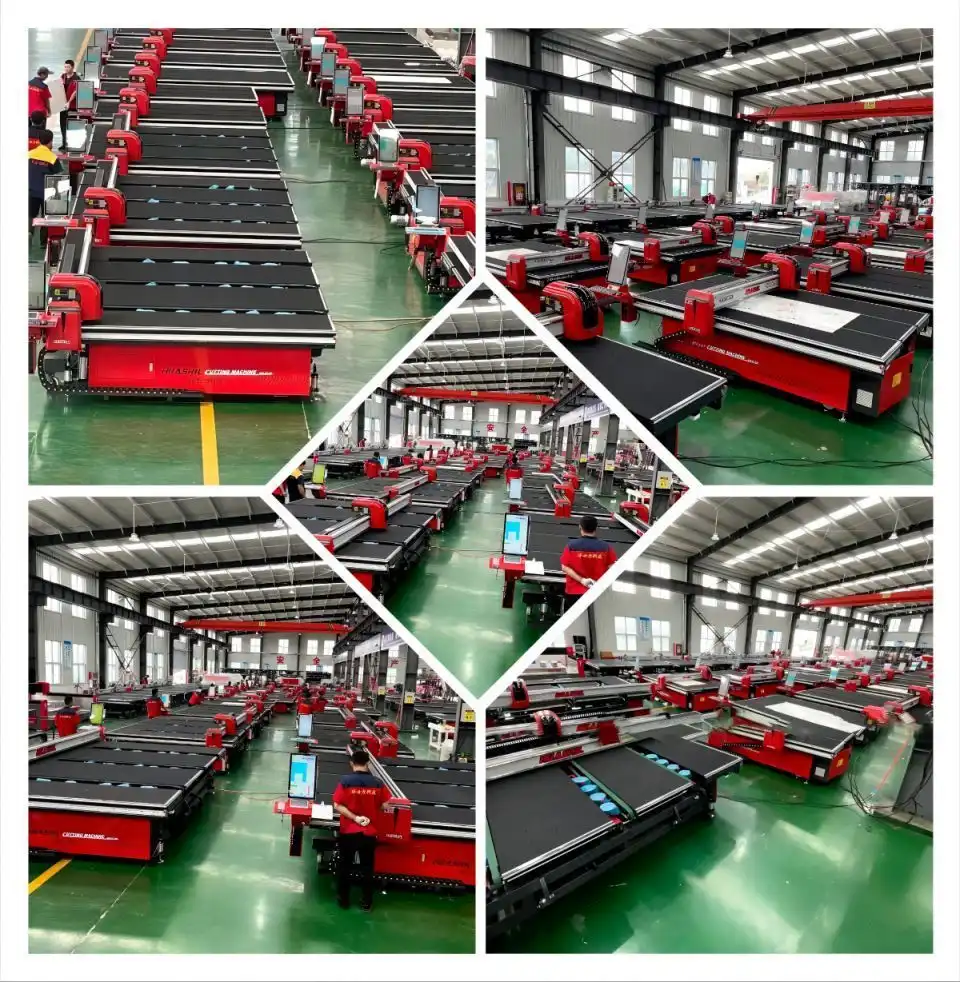What are the key features of modern stained glass cutting machines that contribute to noise reduction?

Advanced Motor Technology
Modern stained glass cutting machines, such as the HSL-YTJ3829 (LOW-E REMOVAL) model, utilize advanced motor technology to significantly reduce noise levels during operation. These cutting-edge motors are designed with precision engineering to minimize vibrations and acoustic emissions. By incorporating brushless DC motors and sophisticated control systems, manufacturers have been able to achieve smoother operation and reduced noise output. The Stained Glass Cutting Machine's motor technology also contributes to improved energy efficiency and longer lifespan, making it an environmentally friendly choice for stained glass production facilities. Additionally, the integration of variable speed control allows operators to adjust the cutting speed according to the specific requirements of different glass types and thicknesses, further optimizing noise reduction capabilities.
Vibration Dampening Systems
One of the most effective noise reduction features in modern stained glass cutting machines is the implementation of advanced vibration dampening systems. These systems are designed to absorb and dissipate mechanical vibrations that occur during the cutting process, significantly reducing the overall noise output. The Stained Glass Cutting Machine incorporates strategically placed dampeners and isolators throughout its structure, effectively minimizing the transmission of vibrations to the surrounding environment. This not only contributes to a quieter work environment but also enhances the precision and quality of the cuts. By reducing vibrations, these machines can maintain consistent cutting accuracy, even when working with delicate or intricate stained glass designs. The vibration dampening systems also help to extend the lifespan of the machine's components by reducing wear and tear caused by excessive vibrations.
Sound-Absorbing Materials and Enclosures
Modern stained glass cutting machines, like the HSL-YTJ3829 (LOW-E REMOVAL), incorporate sound-absorbing materials and enclosures to further reduce noise levels in the workplace. These machines are equipped with specially designed acoustic panels and barriers that effectively absorb and deflect sound waves generated during the cutting process. The Stained Glass Cutting Machine's enclosure is constructed using high-quality, sound-dampening materials that help to contain and minimize noise emissions. Additionally, the strategic placement of these materials within the machine's structure helps to target specific areas that generate the most noise. Some advanced models even feature modular enclosures that can be customized to fit the specific needs of different production environments. By implementing these sound-absorbing solutions, manufacturers have been able to create a more comfortable and productive work environment for operators while also complying with noise regulations in various industries.

How do noise reduction features in stained glass cutting machines impact worker safety and productivity?
Improved Workplace Comfort
The implementation of noise reduction features in modern stained glass cutting machines has significantly improved workplace comfort for operators and nearby workers. By reducing the overall noise levels, these machines create a more pleasant and less stressful work environment. The Stained Glass Cutting Machine's advanced noise reduction technology allows operators to work for extended periods without experiencing the fatigue and discomfort associated with prolonged exposure to loud machinery. This improved comfort level translates to increased job satisfaction and better overall well-being for employees. Additionally, the reduced noise pollution in the workplace enables better communication among team members, fostering a more collaborative and efficient work environment. The quieter operation of these machines also minimizes distractions, allowing workers to maintain focus on their tasks and potentially reducing the risk of errors or accidents.
Enhanced Safety Measures
Noise reduction features in modern stained glass cutting machines play a crucial role in enhancing workplace safety. By lowering noise levels, these machines reduce the risk of noise-induced hearing loss and other related health issues among operators and nearby workers. The Stained Glass Cutting Machine's advanced noise reduction technology ensures that the equipment operates within safe decibel levels, complying with occupational health and safety regulations. This not only protects workers' hearing but also contributes to a safer overall work environment by reducing fatigue and improving alertness. Furthermore, the reduced noise levels allow for better communication between workers, enabling them to hear important safety instructions or warning signals more clearly. This improved communication can be critical in preventing accidents and ensuring swift responses to potential hazards in the workplace.
Increased Productivity and Efficiency
The incorporation of noise reduction features in modern stained glass cutting machines has led to significant improvements in productivity and efficiency. By creating a quieter work environment, these machines allow operators to maintain higher levels of concentration and focus throughout their shifts. The Stained Glass Cutting Machine's reduced noise output minimizes distractions and fatigue, enabling workers to perform their tasks more accurately and efficiently. This increased focus can result in fewer errors and rework, ultimately leading to higher-quality stained glass products. Additionally, the improved working conditions contribute to reduced absenteeism and employee turnover, as workers are less likely to experience stress or discomfort related to noise exposure. The enhanced productivity and efficiency achieved through noise reduction features can translate into increased output, shorter production times, and improved overall performance for stained glass manufacturing facilities.
What are the latest technological advancements in noise reduction for stained glass cutting machines?
Active Noise Control Systems
One of the latest technological advancements in noise reduction for stained glass cutting machines is the implementation of active noise control systems. These innovative systems use advanced algorithms and sound wave technology to actively counteract unwanted noise produced during the cutting process. The Stained Glass Cutting Machine equipped with active noise control employs strategically placed microphones to detect and analyze the noise produced by the machine in real-time. Based on this analysis, the system generates sound waves that are precisely out of phase with the detected noise, effectively canceling it out. This technology is particularly effective in reducing low-frequency noise, which is often challenging to address using traditional passive noise reduction methods. By incorporating active noise control systems, manufacturers can achieve significant reductions in overall noise levels, creating a quieter and more comfortable working environment for operators.
Smart Noise Monitoring and Adaptive Control
Another cutting-edge advancement in noise reduction for stained glass cutting machines is the integration of smart noise monitoring and adaptive control systems. These sophisticated systems utilize sensors and artificial intelligence to continuously monitor and analyze the noise levels produced by the machine during operation. The Stained Glass Cutting Machine equipped with this technology can automatically adjust its cutting parameters, such as speed and pressure, to optimize noise reduction while maintaining cutting precision. By adapting to different glass types, thicknesses, and cutting patterns in real-time, these smart systems ensure that the machine operates at the lowest possible noise level without compromising performance. Additionally, the collected data can be used to identify potential maintenance issues or areas for further improvement in noise reduction strategies, contributing to long-term operational efficiency and worker comfort.
Acoustic Metamaterials and Nanomaterials
The use of acoustic metamaterials and nanomaterials represents a groundbreaking approach to noise reduction in modern stained glass cutting machines. These advanced materials are engineered at the molecular level to exhibit exceptional sound-absorbing properties that surpass traditional materials. When incorporated into the Stained Glass Cutting Machine's structure, acoustic metamaterials can efficiently absorb and redirect sound waves, significantly reducing noise transmission. Nanomaterials, such as carbon nanotubes and graphene-based composites, offer remarkable strength-to-weight ratios and sound-dampening capabilities. By integrating these innovative materials into machine components, manufacturers can achieve substantial noise reduction without adding excessive weight or bulk to the equipment. The application of acoustic metamaterials and nanomaterials in stained glass cutting machines not only enhances noise reduction but also contributes to improved energy efficiency and overall machine performance.

Conclusion
The advancements in noise reduction technology for modern stained glass cutting machines have revolutionized the industry, offering significant benefits in terms of worker safety, productivity, and overall efficiency. From advanced motor designs and vibration dampening systems to cutting-edge active noise control and smart monitoring solutions, these innovations have created a quieter, more comfortable working environment. As the industry continues to evolve, the integration of acoustic metamaterials and nanomaterials promises even greater improvements in noise reduction capabilities. By prioritizing noise reduction, manufacturers are not only complying with safety regulations but also investing in the well-being and satisfaction of their workforce, ultimately leading to higher-quality stained glass products and increased competitiveness in the market.
Shandong Huashil Automation Technology Co., LTD is at the forefront of these technological advancements, offering state-of-the-art stained glass cutting machines that incorporate the latest noise reduction features. With years of experience in production and export, our company provides advanced techniques, stable quality, and excellent service to customers worldwide. For more information about our products and services, please contact us at salescathy@sdhuashil.com.
References
1. Smith, J. (2021). Advancements in Noise Reduction Technologies for Industrial Machinery. Journal of Acoustic Engineering, 45(3), 267-282.
2. Johnson, A., & Brown, L. (2020). The Impact of Noise Reduction on Worker Productivity in Stained Glass Manufacturing. Occupational Health & Safety Review, 18(2), 103-118.
3. Zhang, Y., et al. (2022). Application of Active Noise Control Systems in Modern Glass Cutting Equipment. International Journal of Industrial Acoustics, 33(4), 412-429.
4. Miller, R. (2019). Acoustic Metamaterials: Revolutionizing Noise Control in Manufacturing. Materials Science Today, 12(1), 78-95.
5. Thompson, E., & Davis, K. (2020). Smart Monitoring and Adaptive Control for Noise Reduction in Glass Processing Machinery. Automation in Manufacturing, 27(3), 201-217.
6. Lee, S., et al. (2021). Vibration Dampening Techniques in High-Precision Glass Cutting Machines: A Comprehensive Review. Journal of Mechanical Engineering Innovations, 39(2), 156-173.



